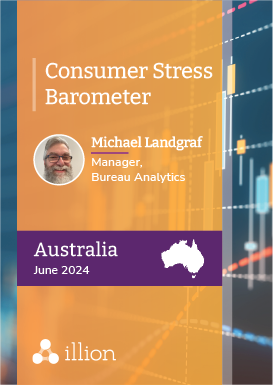SYDNEY; 12 June 2024: NEW data released today by credit bureau, illion, as part of its latest Consumer Credit Stress Barometer, shows credit stress on the rise again, with younger Australians (who are mostly excluded from home ownership) struggling to ‘get ahead’ financially, due to burdens of higher rent and higher servicing costs on personal borrowings.
After improving over the second half of 2023, credit default risk in Australia has deteriorated to a level last seen in October 2023, with both February and March 2024 showing signs of higher risk. As a long-term trend, it is now 9% higher than at the start of 2022.
If worsening circumstances cause an even greater shift in this stress, Australia risks having a social divide open between older and young Australians creating in effect, a ‘Gen-Z recession’.
“It’s a real concern that the credit default risk of Australians under 30, and Australians holding non-mortgage loans such as personal loans and lines of credit has risen substantially,” said Barrett Hasseldine, illion’s Head of Modelling.
“Both are up 2-2.5% in the March quarter. This means that credit stress is spilling over into social groups that are less economically stable. Younger people generally have lower savings, lower incomes, fewer assets, and limited employment experience.”
These findings coincide with most Australians suffering from broader economic woes that are affecting their propensity and ability to spend, irrespective of whether that spending is for consumptive or productive purposes.
Specific observations in illion’s latest report that support this are that consumer confidence has fallen consistently in the last quarter – trending lower in each month. Also, far fewer new mortgages have been taken out by Australians on lower incomes, relative to their debt, while their rent has risen substantially year on year. Renters are now, in effect, further underwater financially.
Personal loans becoming a problem
While 2023 saw mortgage holders suffering credit stress, so far 2024 has shown that young borrowers with personal loans are now suffering credit stress, all this, while older Australians remain relatively comfortable.
“In 2023 we saw the credit default risk of 30-somethings, and even 40-somethings, rise quite substantially, however the picture in 2024 appears to be quite different,” added Mr Hasseldine. “The quarterly rise in the default risk of people in their 30s slowed from 2 per cent to 1.5 per cent in the March quarter and the default risk of Australians in their 40s fell by around 1% in the quarter after rising by an average 1.5 % per quarter in 2023.
“Conversely, the wolves are baying at the door of Gen-Z borrowers, who have struggled with their credit obligations in the March quarter. The rise in the default risk of younger Australians (aged 26-30) has accelerated by more than 30% when compared to the average quarterly rise in 2023 – an increase from 1.5% to 2%.
“Worse still, the rise in default risk for Australians aged under 26 has accelerated by an incredible 100%,” he said.
Overall, illion’s report suggests that Australians holding personal loans, or ‘lines of credit’ found it harder to service their credit obligations in the March quarter. In the case of personal loan borrowers, the rise in their default risk accelerated by 300% over the 2023 quarterly average, from 0.6% to 2.4%, and by around 85% for borrowers with a revolving ‘line of credit’ (from 1.3% to 2.4%).
As such, consumers with little or no access to mortgage capital, cheaper mortgage debt, or savings showed worsening signs of credit stress. This change in risk affected both prime and sub-prime borrowers, meaning that a broad range of renters and young Australians are currently suffering financially.
By state
illion also notes that the March quarter saw the default risk of personal loan consumers rise across all five major Australian states. Consumers in WA deteriorated the most (4% rise in default risk), followed by those in NSW (3% rise) and then VIC, QLD, and SA (all around 2% higher).
The smaller states and territories saw a fall in credit risk amongst personal loan consumers, although it should be noted that home loan risk appears to be on the rise in Tasmania, suggesting there are local economic issues affecting Tasmanian consumers.
Consumer confidence slowly evaporating
Australia saw a 4% fall in consumer confidence in the March quarter.
“While this was not as substantial as the previous quarter’s rise, the downward trend was consistent over all three months, with no clear sign of a turnaround evident,” Mr Hasseldine said.
“Therefore, with the March quarter seeing a period of heightened credit stress amongst the young and economically challenged, it also saw Australians show lower confidence in their finances. This does not bode well for consumer spending over the foreseeable future and may point to a growing risk of recession in 2024, especially if stage 3 tax cuts do not deliver sufficient financial relief for struggling households.
“This suggests that as higher rents continue to erode savings, the young and economically challenged are being priced out of the home ownership market. Lower to middle income Australians, whose debt is more than six times their income, now make up only 5% of new mortgagees, compared with 24% in late 2021. As such, without any financial relief, these Australians will have an ‘up-hill battle’, trying to escape the rental trap. Sadly, the Australian home ownership dream seems further out of reach than ever before.”
With little possibility of owning a home or of accumulating savings, Australia can’t rely on the young to support the broader economy.
How this stress plays out in 2024 will be contingent on household budgets, which will be largely influenced by movements in interest rates, CPI (especially rents), and the ability of Australians to stay employed if a broad recession occurs. This poses both long-term economic and social challenges, and the risk of recession in 2024 also needs to be closely monitored.
-ENDS-
Australian Consumer Stress Barometer Report
The June 2024 Australian Consumer Stress Barometer shows younger Australians (who are mostly excluded from home ownership) are struggling to get ahead financially, due to burdens of higher rent and higher servicing costs on personal borrowings.
Australia risks having a social divide open between older and young Australians creating in effect, a ‘Gen-Z recession’.
This is a report by Manager of Bureau Analytics, Michael Landgraf
Want to learn more?
Fill in this form to talk to our friendly team today.

